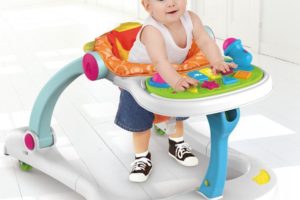
image: iStock
A child’s buttocks, knees, and feet touch the floor when they sit on the ground. But for babies and toddlers who sit in the W-position, their buttocks come between their legs. Their knees are bent with legs rotated away from their body. If one looks at them from the top, their legs resemble the letter “W” (1).
While W-sitting is commonly seen in toddler years, many believe it to be harmful as the child grows older. If your baby or toddler sits in the W-position, this post will help you understand the implications of W-sitting on the growth and development of the child’s body.
What Are The Risks Associated With W-Sitting?
The following risks could be associated with W-sitting in children (1) (2) (3).
- Children get a wider base of support when they sit in the W-position. Thus, they do not activate their core muscles when W-sitting.
- An unstable core may lead to issues with the development of fine and gross motor skills. It may also lead to weak shoulders and poor wrist stability.
- While sitting in the W-position, babies and toddlers have fewer opportunities to shift their weight from one side to another. They may also have trouble rotating their trunks when picking toys from the floor.
- This lack of cross-body movements may also cause problems with left and right side coordination.
- It may eventually lead to issues with their bilateral coordination. It may reflect in daily life when the child shows problems with everyday activities, such as wearing clothes and using utensils during meal times.
- The W-sitting may cause unnecessary stress on the hip and knee joints, causing postural problems, hip pain, or lower back pain in the long run.
- W-sitting increases a child’s risk of hip dislocation, especially in children with hip dysplasia. It leads to pain and difference in the length of the legs.
- Long-term W-sitting could tighten and shorten the leg muscles leading to “pigeon-toed” walking. It may hinder normal gross motor activities, such as jumping, climbing, running, and riding a bicycle.
- W-sitting may cause inward turning of the child’s feet, knees, and thighs. It may cause in-toeing and flat feet.
- W-sitting may also lead to slouching, leading to a poor sitting posture.
- W-sitting is could also be responsible for tight hamstrings, weak trunk, and weak core muscles.
- W-sitting could exacerbate muscle tone-related problems in babies with neuromuscular disorders such as cerebral palsy.
Is W-Sitting Always Bad?
According to the International Hip Dysplasia Institute, W-sitting is commonly seen in toddlers around three years of age. It is normal for many toddlers to sit in this position a few times a day while shifting between various sitting positions. Sitting in W-position a few times a day may usually not cause any problems. However, if the toddler sits in the W-position often or always sits in the W-sitting posture, it may lead to long-term issues (3).
What Can You Do About Your Child’s W-Sitting?
If the toddler sits in the W-position a few times a day, it is not usually a problem. However, if they choose to sit in the same position for a longer period or always, you might need to encourage them to change the position. The following steps may help you (3) (4).
1. Use positive verbal cues. Instead of saying, “Do not sit like that,” you may try saying one of these:
- Try sitting in a crisscross position
- Fix your legs
- Criss-cross, applesauce!
- Feet in the front, please
- Feet forward, please
- Feet are friends, and they stay together
- Sit on your bottom, please
Choose a phrase or a tagline and inform your family about it. Let everyone know what they should say when they see the baby in a W-sitting position.
2. Give them small bean bags or stools to sit on while playing. It will make them move around more often.
3. Encourage them to play games that make them move more, such as twister games, outdoor games at playgrounds, tunnel-crawling games, or home obstacle courses.
4. Buy them a kid’s activity table. It will encourage them to play up higher in half kneel or a tall kneel position.
5. Being on hands and knees or the tummy can be two good playing positions, especially for babies.
Stretches For W-Sitting Posture
Prolonged sitting in a W-position may cause severe tightness in the muscles. You may playfully engage them in the following stretches. Each stretch should last for at least 30 seconds (4).
- Hip stretch: Let the child sit with their legs stretched out in front of them. Ask them to bend their knees and touch the soles with one another. Kneel in front of the child. Gently apply pressure on their legs with your hands to stretch their leg muscles.
- Hamstring stretch: Make the child sit on the floor with their legs parallel to each other and pointed out. You can sit in front of the child in a similar position. Reach for your child’s hands and gently pull them towards you. Ask them and confirm that they are feeling the stretch in their legs and not in their back.
- Ankle stretch: Make the child lie on their back. Hold their foot in your palms, apply slight pressure on the toes, and flex the foot upward. Hold for 30 seconds once you feel the resistance.
- Foot stretch: Let the child lie on their back. Hold the child’s heel with one hand. Use the other hand to gently push the feet in the outward direction — the direction of the smallest toe. This stretch could help minimize the inward rotation of the feet due to W-sitting.
Core Exercises To Help Decrease W-Sitting
A strong core helps improve overall strength and posture. You may engage your child in the following exercises to improve their core strength (4).
1. Crab position

image: iStock
Make them sit on their bottom with their knees bent and feet flat on the floor. Ask them to place the hands behind their hips on the ground. Then, tell them to press their hands and feet down and lift their hips high. To make it fun, place the child’s feet on sliders or paper plates and ask your child to straighten one leg at a time to reach a slide or paper plate.
2. Ankle sway

image: iStock
Make the toddler lie down on their back with their hands behind their head. Ask them to prop their head up with the help of their hands while also raising their legs. Place a balloon or ball between their ankles. Ask them to draw imaginary letters or pictures while holding the ball between their ankles all the time.
3. Boat position

image: Shutterstock
Lay the child on their back and ask them to keep their arms and legs in the air. Ask them to keep their legs either straight or knees bent at 90 degrees angle. Balance a toy on their feet and encourage them to hold it and not let it fall.
4. Hands and legs crawl

image: iStock
Ask your child to crawl on their hand and their feet instead of their knees. This exercise can strengthen their core. You may make it more challenging by placing paper towels under the toddler’s feet and palms since it will require them to hold their balance carefully.
5. Knee walking

image: Shutterstock
Let the child walk on their knees while playing. You may place toys or other interesting objects and ask the toddler to reach out to them while walking on their knees.
Alternative Sitting Options For A Child’s W-Sitting
The following alternative sitting options may help your toddler quit the habit of W-sitting.
1. Cross-legged

image: iStock
Crisscross or cross-legged posture is a common sitting position. Encourage the toddler to keep their back straight to help strengthen the core.
2. Side-sit

image: iStock
The child bends both the knees and puts the legs out on the same side. This position relieves stress from the hip joint. It also helps transit from one position to another easily. Encourage the child to side-sit on both sides for equal development.
3. Long-sit

image: iStock
The child’s feet are stretched out straight in front of them. The back may be supported or unsupported. Unsupported back during this sitting posture could help strengthen the core muscles.
4. Short kneel

image: iStock
The toddler sits with their feet tucked under their bottom and the ankle in a folded position. It can help strengthen the hip and core muscles.
5. Half kneel

image: iStock
The child sits with one foot tucked under their buttocks and the other foot kept flat on the ground. This position activates and stretches several muscles at once.
6. Squat

image: iStock
Squatting is the best way to improve the overall core strength and strengthen the hamstring, glutes, and quads.
When To Call A Doctor?
Contact your pediatrician, pediatric therapist, occupational therapist, or physiotherapist if you notice any of the following signs or conditions in your baby or toddler (3).
- Low muscle tone
- Poor muscle mobility and range of motion
- Tightness in hips
- Lack of balance
- Delay in fine motor skills
- Prolonged use or preference for W-position
- Pain when sitting in any position other than W-position
W-sitting is often common in toddlers, but most grow out of it eventually. Prolonged W-sitting or a preference for W-sitting may indicate an underlying problem, such as poor muscle tone. Some toddlers with neuromuscular disorders may prefer the position often. Speak to a doctor if the child does not respond to exercises or you have any other concerns.
References:
2. THE TRUTH ABOUT W-SITTING;The Child Development Centre
3. Should W-Sitting Be A Cause For Concern For Parents?;SPD Singapore
4. The 101 on W Sitting;NAPA Center

































